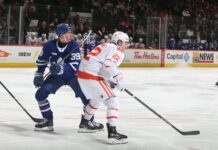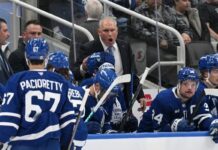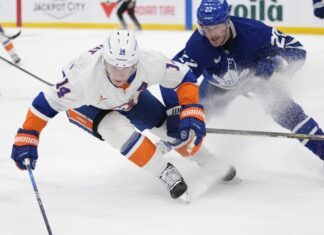 Thanks a lot to Mr. Morrison for taking the time out of a busy schedule to answer a few questions.
Thanks a lot to Mr. Morrison for taking the time out of a busy schedule to answer a few questions.
Q: You joined the Leafs as an amateur scout in 2004 before being promoted to director of amateur scouting in 2006. How has the approach to the draft changed, if at all, under Brian Burke?
A: We’re not right into the nitty gritty just yet; maybe there’s more emphasis on a certain type of player but I don’t think it’s changed in terms of the work and the background and the due diligence that we go through with these players. Brian’s expectations are high and so they should be and we’re working hard to meet them. I think they were high with the other two guys [Fletcher & Ferguson] too. We’re trying to do our best here, doing what we have to do in getting the best possible players that can play in the NHL.
Q: When you say that there’s more emphasis on a certain type of player, Burke—s made it no secret that sizing up is a priority. Fletcher appeared to have gotten the ball rolling in this respect last draft as I believe he didn—t draft a player south of 6—2. Has the size factor been overblown or has it significantly factored into the value or ranking of a prospect by the organization?
A: It’s always been and always will be something that you factor in. It’s one of those things – there’s players that are 6’4 that play like their 5’8 and players that are 5’8 that play like their 6’4. It’s true and it’s not necessarily the size but how you use the size and how you play. Naturally, there are some advantages with size in terms of reach, ability to defend or protect the puck. There’s a lot of different advantages to being bigger but at the end of the day you better use that size if you have it. So, size is great all things being equal. But if it’s not equal then you really want to go with the best possible player.
Q: When the press conference was held for Brian Burke he listed off a series of attributes and characteristics to which he molds his team that had us all scrambling for our dictionaries. Essentially, toughness, leadership and accountability all seemed to be attributes of emphasis. How do you measure intangibles such as the leadership and accountability of a player when considering their draftability? How much does an intangible like leadership affect a value of a prospect, particularly in your circumstance?
A: We do a lot of homework. The way they play sometimes tells you a lot of those things too. Their effort, competitiveness and the way they handle certain situations. That’s the one thing and then of course we do a lot of follow up work, a lot of follow up interviews not only with the players but with the coaches. We do character assessments. We do a bunch of different things to determine if a particular player has those attributes. It’s a matter of doing your homework and making a lot of phone calls and doing all the background checks. Basically what you see on the ice isn’t what they are. And that’s what we’re trying to find out.
Q: How much stock does the organization place in the interview process?
A: It’s important but it’s not the most important. Most important is how they play; what kind of player are they and do they bring the things that we want them to bring to to the table. The interview process a lot of the time serves as a vehicle to back up what you think or your feel a player is. That’s what you want the interview process to do. Sometimes the players are very different – their on-ice is persona is very different from their off-ice persona. And it’s kind of different when that happens but it does happen. That doesn’t mean they’re not players. It’s just that some players are very abrasive, loud and chirpy on the ice. Get them off the ice and they’re quiet kids. Very quiet, very well liked. The interview process is important but it’s just part of the information gathering, just another small piece of the puzzle.
Q: Since the re-build—s really begun in Toronto, have you noticed an increased emphasis on drafting on the part of the organization? Or does your job remain relatively the same regardless?
A: It’s always been important to draft well. I think that maybe there’s more attention to it now. I think that all GMs and management people of all teams have always understood the value of good drafting. It’s an integral part of the process and I think that post-lockout there’s a lot more attention to it. It’s great for the scouting community and there’s a lot of hard work that goes into it.
Q: Considering the Leafs— current position – seventh in the draft order – who would you say you—re more likely to go with – a good, solid can—t miss prospect – or a possible game-breaker that may be less of a sure thing?
A: That’s quite a question actually. It depends. If the gamebreaker player has certain attributes that you feel strongly about that are gonna give him a maximal chance to achieve his potential then I don’t think there’s any reason you wouldn’t draft a player like that. When we do all this homework and all the background and all this phoning and follow-up work, that’s what we’re trying to find out. Do they have the characteristics to take them where they want to go and where we want them to go. But that’s a a heck of a question and every circumstance is different but I think we always take the player that has the best chance of being an NHL player. I think that when we put our list together, it’s all factored in together, whether they’re a safer type of player or a more skilled player. There’s a lot of skilled players ahead of the safe players because we feel they have a better chance at being a greater player in the NHL. I don’t think we go in with a predisposition to take a player for that reason.
Q: Obviously, much of Detroit’s success has stemmed from good drafting – not by holding onto all their draft picks necessarily but by making good with what they have, especially in the later rounds. What are the qualities that you look for in a player when trying to uncover hidden gems later on in the draft?
A: When I first started scouting, a lot of the older scouts would say “find a player that has an NHL quality.” It could be only one quality, but do they do something better than everyone else? As an example, a player might be an unbelievable shooter and can score but maybe isn’t a bigger player or the greatest skater but for some reason can find a way to score. At the end of the day, they’re 18 years old, so if they already have that one NHL quality, by the time they’re 22, you may be able to develop the other qualities to be NHL-efficient so that the player can take advantage of that one quality. When you’re looking for those diamonds in the rough I think that’s what you’re looking for. Detroit’s certainly done a great job with those European guys late in the draft. It’s not just that team but there’s a whole development process that goes into it. I think that’s where we’ve made a lot of strides in the last few years here – with the development thing – and I think that’s going to pay dividends in the next few years here. It’s a whole process that has to take place. Drafting a player is one thing, developing them is another. As an organization we’re working hard at that part too.
Q: This has been a bit of a talking point concerning the Victor Hedman/John Tavares debate: how much would you say you base a prospect—s value on past performance versus that of potential?
A: That’s a good question too. You definitely think of both and you factor both for sure. Past performance is great but if the potential is lacking, how much further is he gonna get? The landscape is full of players who were great junior hockey players but weren’t very good pros. Past performance is great only if the potential is there to produce the same as a pro. Because there are those players that seem to get a little bit better every year after year after year and become pros and keep getting better and all of a sudden they’re more of the scorers than the big guns so to speak back in junior or midget. You factor both in, but it’s nice to know they have that history to know that they have that ability and if the potential is still there you may have something.
Q: One reader was wondering whether you would rather the two second rounders you have or one middle to late first round pick?
A: That is another good question. Depends on which player is there and how much we like him. Those are the decisions that all teams go through and if there’s somebody that we think has maybe slid and is a player that we really covet and we feel that we should really make a deal to move up and get this guy we’d look at it. All teams are doing this at the draft, they’re trying to determine where the best value is. It almost depends on how the draft itself goes. But it is a good question and we’ll look at all possible scenarios. At the end of the day, the draft itself is 5 years later basically when you know what you’ve got in front of you. Whether those two seconds would be better than a late first I don’t know just yet.
Getting into more specifics pertaining to this year—s draft class¦
Q: Out of the 3 traditional sources of draftees (Canadian Major Junior, College, and Europe), is there a particular source that stands out this year as stronger or weaker than usual?
A: I know one thing, that from Europe, I wouldn’t say that Europe is stronger or weaker than any other year, but I think there are an inordinate amount of Swedish players this year. It’s really weighted heavily on the Swedish side in Europe. But other than that, in terms of the NA class, it’s pretty even. I wouldn’t say its any different than other years.
Q: Last year, Cliff Fletcher identified that the elite of the draft class consisted of about 5 players and pulled the strings to jump up into that range and drafted Luke Schenn. Do you see this draft as similarly having a drop off at any point?
A: There’s been talk about the big five guys. There is a group of five guys that are very good but I think there are a lot of other good guys too. This draft there isn’t as much as a drop off in my opinion from the perceived top guys. I think it’s tough to ignore what some of those top guys have. But I don’t think it drops right off the face of the Earth after the top group.
Q: Have any particular preparations been made should Burke maneuver his way up the draft order?
A: We’ve talked about it and about different scenarios. We’ll be prepared for all possibilities.
Q: Who are some of fast risers in the draft, players who were projected to be mid-draft picks (3rd, 4th) but actually stand a good chance of getting picked much earlier? (I tried).
A: There are a couple of kids for sure but I’m not gonna tell ya.
Q: When looking at prospects who have committed to the NCAA, do you take into account the school they—ve committed to? What qualities do you look for in the school the player will be attending?
A: You want it to be a program where the player is going to play first of all. I guess you like certain players to go to certain schools but it doesn’t always work that way. A lot of development is incumbent on the player himself to make himself a better player. Ideally, you want players going to places where they’re going to play and become better players. Some schools have better track records than others. But at the end of the day, if we really like the player and we think he can be an NHL player, then there’s not many schools I think that you’d not want your player to go to. It does factor in, the school the coaching and everything else. I think it does with any league and any team that a player may be going to.
Getting into a few player-specific questions¦
Q: As it stands, Jared Cowen figures to be drafted somewhere within your pick—s range. When evaluating him, how worrying would you say his health situation is?
A: We’re doing all the background checks on that too. It’s only worrisome until you know the facts. Right now we just about have all the facts. It’s only worrisome if you don’t know the details in terms of what it is, what’s happened to it, how it’s been treated and how the therapy is going. We’re not complete in that process yet but we will be by Friday night. I don’t think it’s a huge problem for the kid.
Q: Many of my readers have been surprised to see Magnus Paajarvi-Svensson dip as low as he has in recent prospect rankings. Bob McKenzie had him at 10th overall last night in his preview show. What are the concerns with him? Are there questions surrounding his natural finishing abilities as often speculated?
A: That’s been a question that’s sort of creeped up with him over the course of the year. Why is that and those type of questions are what we’re going to answer when we have our meetings and do our checks on the kid. I’m sure that’s one of the reasons why but he does a lot of other things well. He’s still a prospect.
Q: How comparable are Evander Kane and Brayden Schenn? Do both possess number one center upside in your opinion?
A: Well Kane will probably play more on the wing I think. I think they both have the potential to be number one line players but time will tell and there’s a lot of development that’s going to have to take place. The potential is there for them to be top 6 forwards for sure. The process of becoming those players is what they’re going to have to go through.
Q: We had a question from a reader concerning Dale Mitchell that asked where you saw him fitting in with the big club a couple of years down the road?
A: Dale’s really had a good year this year and I think he may be a third or fourth line agitating, two-way player that has the ability to score a few goals. I think he’s gonna have to be a hard-working player with a bit of an agitation factor to his game, using speed and his size, which although he’s short he’s not small because he’s got a thick build. And he started to do that this year, he started using it far more to his advantage. I think if those things happen, he’ll give himself a chance.





























![Craig Berube Post Game, Leafs 6 vs. Sabres 3: “Our team played really hard in front of [Murray]… They were dialed in for him” Craig Berube, Toronto Maple Leafs head coach](https://mapleleafshotstove.com/wp-content/uploads/2024/12/berube-leafs-tor-pg-100x70.jpg)


